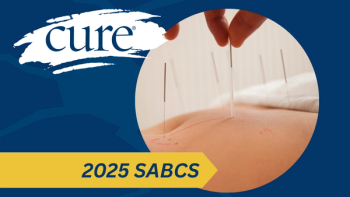
- Fall 2005
- Volume 4
- Issue 3
Unexpected & Unique
The challenges of breast cancer in women under 40.
Breast cancer is usually the furthest thing from your mind when planning for your 30th birthday. But for Jeannine Salamone of Alexandria, Virginia, a breast lump was an uninvited guest. She actually noticed the painful lump a few weeks earlier, but by the time she saw her gynecologist it had gotten bigger and more painful. A mammogram showed suspicious signs of calcifications in the breast and she was sent to a surgeon for a biopsy. “I got the results the next day,” she says, “the day I turned 30, and it was positive for cancer.”
Before her diagnosis Salamone says she had no clue that someone her age could get breast cancer. But she quickly learned that young women do get this disease.
In fact, although breast cancer is more common in older women, about 13,700 women younger than 40 years of age will get breast cancer this year in the United States.
A few of these women, like Salamone, will learn they carry mutations in one of the two known breast cancer genes, called BRCA1 and BRCA2, that greatly increase the risk of ovarian or breast cancer. Most of these young women with breast cancer, however, will not test positive for BRCA1 or BRCA2, although they may carry unknown breast cancer susceptibility genes that have not yet been discovered. In fact, cancer experts believe there are probably many genetic mutations that influence the risk of breast cancer.
The majority of women who carry a BRCA1 or BRCA2 mutation don’t know they have it unless they, or a family member, get tested for it. Sometimes, a family history of breast cancer or ovarian cancer can be a telltale sign of genetic risk, and young women who have two or more first-degree relatives with breast or ovarian cancer might consider genetic testing. Other risk factors include aging, getting your first period at an early age (before age 12), having your first child after age 30, and late age at menopause (after 55)—risk factors that can’t be affected by altering lifestyle. But for the most part no one knows why a woman, young or old, gets breast cancer.
Women under 40 who get breast cancer face unique challenges as they fight the disease. Most find less information and often less support than older women with breast cancer. “Your average 30-something doesn’t know another 30-something with breast cancer,” says Ann Partridge, MD, an oncologist at Dana-Farber Cancer Institute in Boston. “It’s true that most of the research studies in breast cancer are done on older women, but since the discovery of the BRCA genes, we are learning more about breast cancer in young women.”
A cancer diagnosis can feel particularly disruptive at an age when a woman may be just starting out in a marriage or relationship, building a career or starting a family. “Younger women are more likely to be at a stage in their life when things like sexual functioning, beauty and attractiveness, fertility and family planning may be of the utmost importance,” says Partridge.
Meredith Cobb of Colorado Springs, Colorado, had just had a baby at age 26 when her doctor evaluated a bloody nipple discharge. A mammogram and biopsy six weeks later diagnosed stage 1 breast cancer and extensive ductal carcinoma in situ (DCIS) in November 2003.
“I was hysterical,” she says. “I just looked at this little baby and wondered, ‘Am I ever going to see this baby grow up?’” But after a few weeks of roller-coaster emotions and being the youngest woman in the chemotherapy room by at least 30 years, Cobb knew she had to carry on with her day-to-day life as a mom. “I just took the kids to school and went to their games and did all that stuff,” she says.
Usually, the first decision a newly diagnosed breast cancer patient must confront is surgical. In many instances, women can choose removal of the tumor and surrounding tissue (lumpectomy) or removal of the entire breast (mastectomy). Both surgical procedures are considered standard treatment for young women with breast cancer, says Mark Robson, MD, an oncologist at Memorial Sloan-Kettering Cancer Center in New York.
He says that although the complexities for each individual need to be discussed carefully with the breast surgeon, breast cancer patients with a BRCA mutation may also consider prophylactic mastectomy of the healthy breast to reduce the chance of cancer in that breast.
Salamone, who had stage 2B cancer in one breast and a high risk of developing breast cancer in the other breast, opted for a bilateral mastectomy. Cobb, who does not carry a BRCA mutation, also chose bilateral mastectomy because she wanted to treat her disease aggressively and ensure her breasts would match after reconstruction.
Women who choose lumpectomy typically undergo six weeks of daily radiation after surgery to treat the remaining breast tissue. A new method for giving radiation therapy to the breast, however, may influence women’s surgical choices in the future. Researchers are investigating whether radiation directed at only part of the breast, the area directly surrounding where the cancer was found, can work as well as treating the whole breast. This technique, called accelerated partial breast irradiation, uses catheters or radioactive seeds placed inside the breast to deliver radiation directly to the vulnerable tissue. It also only takes days compared with weeks.
“There certainly are some very promising preliminary data using partial breast irradiation,” says Robson. A large randomized controlled trial is currently under way to test the effectiveness of partial breast irradiation, but most oncologists still consider it experimental and recommend conventional radiation in most cases.
Young breast cancer patients often have more aggressive disease than older women. Because young patients can usually tolerate more intense chemotherapeutic drugs, they tend to receive particularly toxic regimens.
Other treatment options are based on hormone receptor status. Women who carry BRCA1 mutations frequently have tumors that are negative for estrogen receptors, progesterone receptors and expression of HER2/neu. Women with these so-called “triple-negative” tumors are in a unique situation, says Partridge.
“These triple-negative cancers are fairly sensitive to chemotherapy but are more likely to come back,” she says. Furthermore, these tumors can’t be treated with targeted hormonal therapies or Herceptin. But Partridge notes that researchers are looking at new chemotherapy combinations to treat these breast cancers. Current trials are investigating whether preoperative Platinol (cisplatin) is effective in women with triple-negative cancer, although this drug is not usually effective in the more common types of breast cancer.
The goal of hormonal therapy for women with estrogen-positive tumors is to rob the cancer cells’ source of estrogen. In young women, the greatest source of estrogen comes from the ovaries. A century ago, one of the first therapies for breast cancer was to remove the ovaries, says Julie Gralow, MD, an oncologist at the University of Washington School of Medicine in Seattle.
The question is, if aromatase inhibitors work better than tamoxifen in postmenopausal women, should we try to shut down young women’s ovaries and give them aromatase inhibitors?
Tamoxifen, the current standard treatment for premenopausal women with breast cancer, blocks the binding of estrogen to the breast receptors in premenopausal women with hormone-sensitive tumors. In postmenopausal women, the ovaries are no longer active and aromatase inhibitors, such as Arimidex (anastrozole), Femara (letrozole), or Aromasin (exemestane), can reduce circulating estrogen in the body to nearly undetectable levels. Although doctors know aromatase inhibitors are ineffective in premenopausal women with functioning ovaries, ongoing studies will determine how best to use aromatase inhibitors and tamoxifen.
Gralow and others, however, wonder if there is a way to still use these powerful medications in young women. “The question is,” says Gralow, “if aromatase inhibitors work better than tamoxifen in postmenopausal women, should we try to shut down young women’s ovaries and give them aromatase inhibitors?”
At age 27, Cobb underwent surgery to have her ovaries removed and began taking Arimidex. “That was the choice I made to essentially starve any cancer cells that could be in there,” she says. Already having three children and two stepchildren before her diagnosis, Cobb says she was less concerned about preserving her ability to have more kids. Still, her choice to instantly enter menopause was not without risk.
Menopause can hasten osteoporosis, says Gralow. It may also speed up a young woman’s risk of heart disease because estrogen from the ovaries may protect against heart disease. Aromatase inhibitors can also cause bone loss, but current research indicates agents called bisphosphonates, such as Zometa (zoledronic acid), can prevent bone loss. Boniva (ibandronate), a newer bisphosphonate taken by mouth once a month, received FDA approval in early 2005 for postmenopausal osteoporosis.
Non-surgical methods that temporarily stop ovarian function have been shown to reduce estrogen in premenopausal women. Medications called LHRH (luteinizing hormone-releasing hormone) analogues, which include Lupron (leuprolide) and Zoladex (goserelin), block signals from the brain that tell the ovaries to cycle. Shots of these medications can suppress the ovaries’ function and reduce estrogen in the body to postmenopausal levels.
Even so, Gralow says there is no conclusive data yet that ovarian suppression or aromatase inhibitors are effective in young, premenopausal women with local breast cancer. A study known as SOFT (Suppression of Ovarian Function Trial) is comparing tamoxifen alone to tamoxifen plus an LHRH analogue to an aromatase inhibitor (Aromasin) plus an LHRH analogue. Results of this study should help determine the optimal hormone therapy for young women with breast cancer.
Young women who plan to have children in the future confront difficult challenges regarding treatment. Both chemotherapy and hormone therapy for breast cancer can affect the ability to have children. Chemotherapy causes some women to enter premature menopause at any time after treatment.
Nevertheless, most patients under 40 will get their periods again after finishing chemotherapy, says Partridge. Hormonal therapy, on the other hand, affects fertility because doctors advise postponing pregnancy until the five-year treatment is over. Salamone, who did not have children when she was diagnosed, is in that position. “I’m in year four of tamoxifen, and there’s still a chance that my husband and I will have a baby,” she says.
In fact, many young women do have healthy children after breast cancer. Some women even elect to temporarily stop hormonal therapy to have a child before finishing the prescribed five years. Few data exist on how this affects recurrence, but for some women it’s an important personal decision.
Young women with breast cancer are truly in a unique position. Most young patients will live long, healthy lives, and they must weigh treatment decisions with that knowledge. “Younger women have a longer time to have long-term complications,” says Partridge, “and we worry about potential risks over time, such as osteoporosis or changes in cardiovascular health and cognitive health.”
Most young women with breast cancer successfully navigate their way through the choices and come out feeling stronger. As Salamone says, now in her fifth year of survivorship, her diagnosis feels like a long time ago. “I’ve moved on and try to do a lot of positive things.”
Articles in this issue
over 16 years ago
Recommended Resourcesabout 20 years ago
The Complexities of Genetic Testingabout 20 years ago
Partial Breast Irradiation: A Convenient Alternativeabout 20 years ago
Screening: Finding the Tumorabout 20 years ago
Passing Isolationabout 20 years ago
HRT: Not Our Mothers' Experienceabout 20 years ago
Accelerated Drug Approval: Taming the Shortcut?about 20 years ago
Speaking Out On Oral Cavity Cancerabout 20 years ago
The Science Behind Obesityabout 20 years ago
v4n3 - Breaking a Bad Habit




